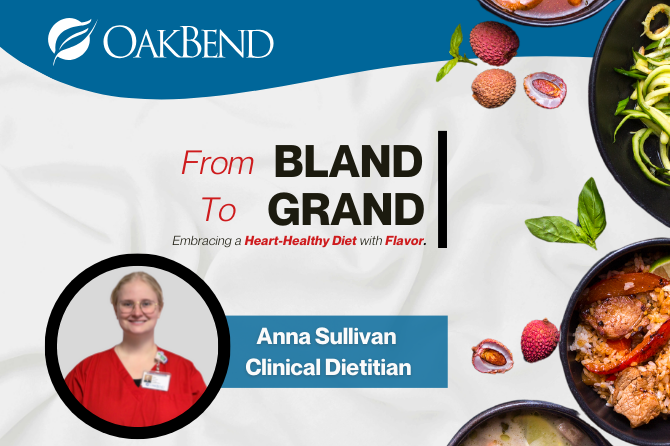
February marks a significant time for heart health awareness. As we wrap up the month, Anna Sullivan, our esteemed dietitian at OakBend Medical Center, shares her insights on transforming the perceived dull heart-healthy diet into a delicious adventure. “Many of my patients believe a heart-healthy diet restricts all the good foods, thinking it’s all bland and boring. I’m here to debunk that myth,” says Sullivan.
The Heart of Healthy Eating
A heart-healthy diet, as Anna explains, is one that’s low in sodium, saturated fats, and eliminates trans fats, but rich in high-fiber foods and unsaturated fats. But what does this mean in simpler terms?
“Saturated fats are what I call the ‘bad fats’,” Sullivan notes. These fats, solid at room temperature, are found in animal products and certain oils, contributing to plaque buildup in the veins. On the other hand, unsaturated fats, the ‘good fats,’ are essential, especially omega-3 fatty acids, which combat inflammation and support overall heart health.
Making the Shift: Practical Tips from Anna Sullivan
Anna shares tangible steps to incorporate heart-healthy choices into daily meals without sacrificing flavor:
Lean into Lean Meats
“Opt for lean meats like chicken, turkey, and pork, trimming away visible fats. When choosing ground meat, select options that are 95% lean protein or higher,” advises Sullivan. This simple change significantly reduces saturated fat intake, aligning with heart-healthy guidelines.
Embrace the World of Whole Grains and Fiber
“Whole grains are your best friend in a heart-healthy diet,” Sullivan states. She encourages choosing brown rice, quinoa, and whole wheat bread over refined grains. These not only provide necessary nutrients but also help manage cholesterol levels.
Reduce Sodium, Not Flavor
Anna warns about the hidden sodium in processed foods and suggests, “Look for products with less than 200 mg of sodium per serving. And remember, cooking at home allows you to control the amount of salt added to your dishes.”
Creative Cooking Techniques
“Healthy cooking doesn’t mean you have to give up on taste,” Sullivan assures. She suggests baking, grilling, steaming, and using herbs and spices instead of relying heavily on salt for flavoring. “Incorporate a variety of spices to add flavor without the added sodium.”
Sweeten Smartly
“To reduce sugar intake, use natural sweeteners like applesauce, honey, or agave in recipes. These alternatives provide the sweetness you crave, without the empty calories,” Anna recommends.
Anna Sullivan’s Closing Thoughts
A heart-healthy diet is not about restriction but about making smarter choices that benefit your heart and overall well-being. Anna Sullivan reminds us, “It’s about balance and making informed decisions that add both nutrition and joy to your meals.”
With Anna’s expert advice, we’re reminded that a heart-healthy diet can indeed be both nutritious and delicious. Her practical tips serve as a guide for anyone looking to improve their heart health through diet. At OakBend Medical Center, we’re committed to providing you with the resources and support you need to live a healthier, happier life.
Call our Nutrition Department at 281-341-4817 to schedule an appointment with one of our expert dietitians, including Anna Sullivan. For more resources and information, visit our Food and Nutrition page at https://oakbendmedcenter.org/food-nutrition/.
Leave a reply








Great post! It’s important to prioritize health and wellness. I found the information here really helpful and informative. Looking forward to more posts like this. Keep up the good work!
ReplyHi everyone, I’m here to give my own verdict about the herbal cure Dr Osato is sending out to people to cure them of Herpes and HIV. Dr Osato herbal medicine is the best remedy for Herpes-1&2 and HIV/AIDS, I was a carrier of Herpes and I saw a testimony on blog on how Dr Osato cure Herpes with herbs, I decided to have a contact with him and asked him for solutions and he started the remedy for my health and prepare the herbal cure for me and send it to me through UPS and he gave me instructions on how to use it which i rightly followed and after 14days of taking the herbal medicine i went for a blood test and my result was Negative. I waited for 3months to confirm my result before sharing this testimony and also to observe myself if i would have an outbreak and nothing came out from my body, i went for another blood test after 3 months of testing Negative and the result still shows Herpes Negative and my doctor was pretty sure i was totally cured from herpes and he confirm with me that I’m free from herpes. Thank God, now everything is fine, I’m cured by Dr Osato herbal medicine, I’m very thankful to Dr Osato and i will not stop publishing his name on the internet because of the good work he did for me, You can contact Dr Osato on email: osatoherbalcure@gmail.com Or you can call and WhatsApp him on +2347051705853. His website is osatoherbalcure.wordpress.com
ReplyWhat transformations were observed in the transition from a bland diet to a grand, flavorful heart-healthy diet as depicted in the article "From Bland to Grand: Embracing a Heart-Healthy Diet with Flavor"?
ReplyFAST EFFECTIVE WAY TO GET CURED FROM HERPES VIRUS
Hello! I’m very excited to share what worked for me to everyone. I’m completely cured from my HSV1&2 with the use of natural medicine. I have used Oregano oil, Coconut oil, Acyclovir, Valacyclovir, Famciclovir and some other products/supplements and it hasn’t helped ever since I was diagnosed. I got outbreaks frequently and was completely devastated and I went online for a possible cure and how to get rid of Herpes.
On a fateful day after taking my bath, I took my phone and was going through some research, I bumped into a testimonial of a Herbs doctor { Dr Awase } who cures diverse diseases/viruses with Herbal medication. I was hopeful but also doubted the claim. But after a while I thought “what do I have to lose?” so I decided to reach out. He prepared a cure using roots and herbs which I steadily took for 14days as prescribed by him. I am quite glad I decided to reach out because I am totally cured from Herpes after a medical checkup was done by my Dr.
So I’ve decided to make a quick testimony for anyone out there who is probably suffering from an illness they can’t handle to reach out to Dr Awase. He specializes in curing lots of illnesses such as HIV, ENDOMETRIOSIS, PCOS, OVARIAN CYST, INFERTILITY, HEPATITIS A,B,C and lots more. I’m here to let you all know that you can also be cured just like me and you don’t have to live with any sort of illness for the rest of your life. To reach out, Contact him via WhatsApp below or Email
WhatsApp +2349074997110
Email:- dr.awaseherbalhome @ gmail .com
ReplyI tested positive for HSV-2 a few months ago, At first, I was devastated thinking I have an incurable STD for life, After doing hours of research I quickly realized genital herpes is a filthy parasite that just likes to hide in your body, there’s no “medical cure” but that doesn’t mean your body can’t get rid of it, I literally got cured with the help of Dr. Riaria natural herbal medicine which I ordered after doing some research and now, I’m HSV-2 Negative, I never believed it until my doctor finally gave me the test results and behold I was HSV free. I’m so glad that I found you Dr. Riaria. Thanks so much for your goodness, I’m grateful. You can also get your help from him through his email: drriaria@gmail.com or WhatsApp him on +2347010627760.
You can visit his website for more info: https://drriaria.wixsite.com/website
ReplyI already gave up on ever getting cured of HSV2 because i have try many treatment none of them work out for me i have gone to different hospital they always tell me the same thing there is no cure for herpes, when i came across a post about Dr UMA in the net from a lady called Angela i contacted her and she reassured me with his herbal medicine which i took according to the way he instructed, that how i was cured. I doubted at first because i have been to a whole lot of reputable doctors, tried a lot of medicines but none was able to cure me. so i decided to listen to him and he commenced treatment, and under two weeks i was totally free from Herpes. i want to say a very big thank you to DR UMA for what he has done in my life. feel free to leave him a message on email dr.umaherbalcenter@gmail.com or also Whats-app him +2347035619585.. he also cure all this 1.HIV 2.HIV HPV 3 .ALS 4. BED WETTING DIABETES.
Reply